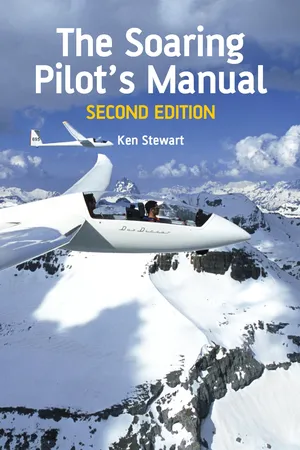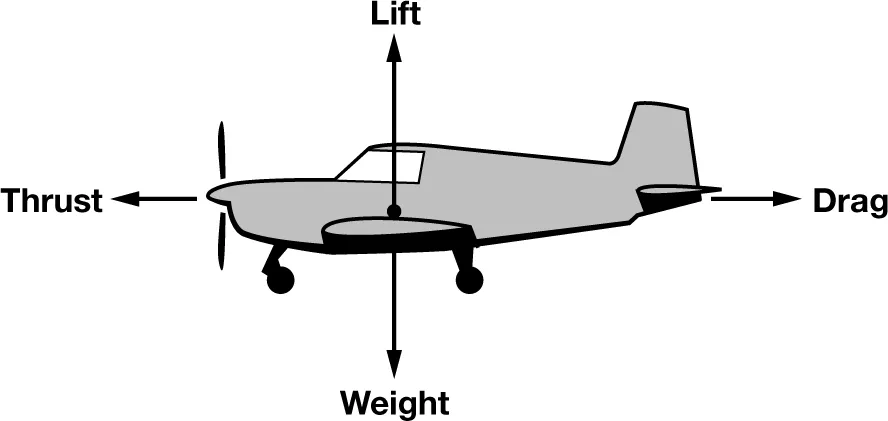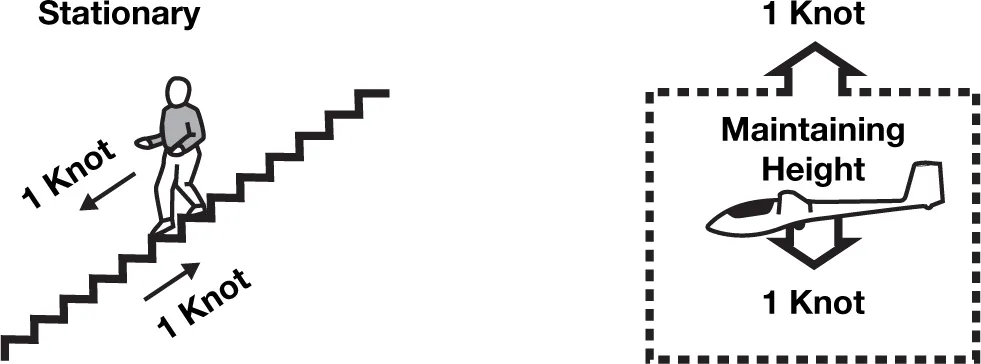
- 384 pages
- English
- ePUB (mobile friendly)
- Available on iOS & Android
eBook - ePub
About this book
The Soaring Pilot's Manual advances the reader from elementary flying to confident soaring by clearly and precisely explaining the basic soaring mechanisms and techniques. Explanatory diagrams illustrate the text throughout, making a complicated subject simple to understand. Having covered the first steps, the book progresses to cross-country flying and the final section contains exercises that will be found useful for any glider pilot wishing to improve his ability and qualifications. The latest technology, such as GPS navigation and instrument systems is covered. Well illustrated with over 300 black & white line drawings.
Frequently asked questions
Yes, you can cancel anytime from the Subscription tab in your account settings on the Perlego website. Your subscription will stay active until the end of your current billing period. Learn how to cancel your subscription.
No, books cannot be downloaded as external files, such as PDFs, for use outside of Perlego. However, you can download books within the Perlego app for offline reading on mobile or tablet. Learn more here.
Perlego offers two plans: Essential and Complete
- Essential is ideal for learners and professionals who enjoy exploring a wide range of subjects. Access the Essential Library with 800,000+ trusted titles and best-sellers across business, personal growth, and the humanities. Includes unlimited reading time and Standard Read Aloud voice.
- Complete: Perfect for advanced learners and researchers needing full, unrestricted access. Unlock 1.4M+ books across hundreds of subjects, including academic and specialized titles. The Complete Plan also includes advanced features like Premium Read Aloud and Research Assistant.
We are an online textbook subscription service, where you can get access to an entire online library for less than the price of a single book per month. With over 1 million books across 1000+ topics, we’ve got you covered! Learn more here.
Look out for the read-aloud symbol on your next book to see if you can listen to it. The read-aloud tool reads text aloud for you, highlighting the text as it is being read. You can pause it, speed it up and slow it down. Learn more here.
Yes! You can use the Perlego app on both iOS or Android devices to read anytime, anywhere — even offline. Perfect for commutes or when you’re on the go.
Please note we cannot support devices running on iOS 13 and Android 7 or earlier. Learn more about using the app.
Please note we cannot support devices running on iOS 13 and Android 7 or earlier. Learn more about using the app.
Yes, you can access Soaring Pilot's Manual by Ken Stewart in PDF and/or ePUB format, as well as other popular books in Technology & Engineering & Aviation. We have over one million books available in our catalogue for you to explore.
Information
Section 1
Basic Soaring
Chapter 1
The Principle of Soaring
The wing of an aircraft, be it an aeroplane or a glider, must move through the air if it is to produce the lift force which is necessary to balance the aircraft’s weight. On a powered aircraft, the engine can produce thrust to move the aircraft through the air, thus causing airflow past the wing. This airflow past the wing creates the lift force that allows an aeroplane to maintain level flight.

Fig 1.1 Forces in balance. In an aeroplane, lift normally balances weight, and thrust normally balances drag.
A glider, on the other hand, not having the luxury of an engine, relies on the force of gravity to propel it forward through the air. A suitable analogy is a ball rolling down a gentle slope. The ball’s forward motion is due to gravity pulling it downward. In fact, if it were not for the surface of the slope, the ball would fall vertically under the influence of gravity. Similarly, gravity would make a glider descend vertically if it were not for the lift force produced by the wing, which, being tilted forward, produces the ‘slope’ down which the glider flies (figure 1.2).
If a glider tries to fly level, then the lift force will no longer be tilted forward, giving no forward component to propel the glider through the air. It will lose airspeed and the reduced airflow past the wing will cause a reduction in the lift force, eventually resulting in the wing stalling.

Fig 1.2 Lift and weight versus drag. The resultant of lift and weight ‘propels’ a glider forward.
Therefore a glider must continually fly ‘down a slope’ to maintain flight. Put another way, it must always descend relative to the air mass in which it is flying.
If the air mass has no updraughts or downdraughts, a glider is said to be flying in STILL AIR. The rate at which a glider descends in still air is dependent on its airspeed – in normal flight, the greater its airspeed, the greater its rate of descent through the air.
As a glider will always be descending relative to the air in which it is flying, in order to maintain height it must be flown in air which is rising at a rate equal to its still air rate of descent. For instance, if a glider is flying in still air at a steady airspeed and is descending at one knot (100 feet per minute), then it will have to encounter an area of air which is ascending at a rate of one knot just to arrest its descent. This would be similar to your walking down an ascending escalator at the same rate as it ascends.

Fig 1.3 Rising air arresting a glider’s descent. A glider will constantly descend unless it is flown in air that is rising at a rate equal to its still air descent rate. This is similar to walking down an escalator at the same rate as it ascends.
To gain height, the air mass in which the glider is flying will need to be ascending at a rate greater than the glider’s rate of descent in still air – that is, in this example, greater than one knot. (Now the escalator has increased its ascent rate.)

Fig 1.4 Rising air causing a glider to gain height. Air rising at a rate greater than a glider’s still air descent rate will result in an increase in the glider’s height. This is similar to walking down an escalator which is ascending faster than your walking speed.
Successful soaring depends on your finding and using such areas of rising air. The first task, finding a suitable updraught, can be challenging enough, depending on the nature of the up-current. Often both experienced and inexperienced glider pilots will fortuitously stumble into an area of rising air. This is often the way in which many pilots achieve their first soaring flights. However, becoming a good soaring pilot depends on learning to consistently seek out rising air. Once a suitable up-current is found, you will need to be able to fly accurately in order to climb efficiently. This will require many of the handling skills that you have gained during your basic training.
NOTE: Often when discussing rising air currents, glider pilots refer to these simply as LIFT. This expression, which will be used extensively throughout the text, should not be confused with the aerodynamic force called ‘lift’, which will be used to a much lesser extent. The context in which the word is used will, hopefully, make its meaning obvious. The expression that is commonly used to describe descending air is SINK.
Various atmospheric phenomena cause air to rise in quantities large enough and at a fast enough rate to keep a glider airborne. The main causes of this lift are:
* | THERMALS, which are parcels of warm air which rise much as a hot air balloon rises |
* | HILL LIFT, where the wind is deflected upwards when it meets the face of a hill or mountain |
* | MOUNTAIN LEE WAVES, which are caused by the deflection of the air mass after it has flowed over a line of hills or mountains |
* | CONVERGENCE LIFT, where two air masses meet, causing air to be forced upwards |
All of these are discussed in the chapters that follow.
Chapter 2
Thermals
The earth’s atmosphere
The earth is surrounded by an envelope of gases, which we call the atmosphere. We live in that atmosphere. Not only do we live in it, we live under it. By living on the earth’s surface, virtually all of the atmosphere is above us. The atmosphere is retained around the earth by the pull of the earth’s gravity, which gives weight to the mass of air aloft.
As an object ascends through the atmosphere, the pressure acting on it reduces. Most people who have ascended or descended quickly in an aircraft have sensed this change of pressure on their eardrums. If the object has no firm sides (such as a child’s balloon or a bubble of air), when it is relieved of some atmospheric pressure, it will expand. When air expands it cools. When air descends, it is compressed and as a result warms up. This latter fact can be experienced when using a bicycle pump – compressing the air heats up the pump barrel.
At first, these facts may seem academic, but as we go on to discuss thermals, and indeed air movement in general, remembering them will help you understand the reason why the air behaves as it does.
The environmental lapse rate
The sun emits large amounts of energy, some of which reaches the earth. Some of this energy is scattered and filtered by the atmosphere, but much of it reaches the earth’s surface and causes it to warm up. The energy that passes through the atmosphere does not heat the air directly, as it is in the form of short-wavelength radiation, which is not absorbed by the air. However, when it reaches the earth’s surface, this energy is absorbed by the land and seas, and surface heating occurs. In a sense, the atmosphere acts like the glass of a greenhouse, in that the glass itself does not get warm, but the non-transparent contents of a greenhouse do.
When the earth’s surface warms up, it re-emits some of this energy as longer-wavelength radiation, and much of this is absorbed by the atmosphere. The result is that the air close to the surface is heated due to its contact with the warm ground, and not directly by the sun.

Fig 2.1 Solar heating and the environmental lapse rate. The sun heats the surface of the ground without significantly heating the atmosphere. The warm ground then heats the air close to the ground. Therefore, the temperature of the atmosphere generally reduces as altitude increases.
Therefore, air temperature decreases as altitude is increased. With minor local variations, this general rule holds good for altitudes up to around 36,000 feet. The rate at which the temperature decreases with altitude on any one day is known as the ENVIRONMENTAL LAPSE RATE (ELR).
The ELR will not only vary from day to day but will also vary as altitude increases. In fact, over certain altitude bands the temperature may stop decreasing with height, giving what is called an ISOTHERMAL LAYER. Often, the temperature trend may reverse and increase with altitude for a time. This increase of temperature with height is called a TEMPERATURE INVERSION, or simply an INVERSION.

Fig 2.2 The environmental lapse rate. Air temperature normally decreases as altitude increases.

Fig 2.3 An inversion is where air temperature increases as altitude increases.
How thermals form
When the sun’s energy strikes the earth, different surfaces will heat up at different rates, as will the air coming into contact with them. This differential heating will mean that adjacent areas of air may vary in temperature by several degrees.
As the temperature of a parcel of air increases, it becomes lighter and will want to rise. If the temperature difference between this parcel of air and the air surrounding it is great enough, then, should it become dislodged from the surface, it will ascend. This rising parcel of air is what is known as a THERMAL. As it ascends, the atmospheric pressure upon it decreases, allowing it to expand. As it expands, it cools. This cooling occurs at a rate of 3°C per 1,000 feet. This figure is known as the DRY ADIABATIC LAPSE RATE (DALR).

Fig 2.4 Dry adiabatic lapse rate. As a parcel of air rises, it cools at the dry adiabatic lapse rate.
If the DALR is greater than the ELR, then the thermal will eventually reach a height at which its temperature is the same as its surroundings. In theory, when the thermal reaches this height it will stop ascending. (In practice, as the thermal may contain as much as 50,000 tons of air rising at possibly 1,000 feet per minute, its momentum will carry it some height above this temperature equilibrium level. This is one reason why it is not uncommon to find thermals bursting through an inversion, to temporarily leave either a haze dome or a cumulus cloud showing above the inversion.)
Up to this height, this air mass is said to be UNSTABLE. Above this height, STABILITY is said to exist.
When a thermal reaches an inversion, it is entering a layer where the air becomes warmer with height. The rising thermal soon finds itself colder than its environment, loses buoyancy and starts to sink. The inversion acts like a lid, limiting the top of convection.

Fig 2.5 DALR greater than ELR. When the DALR is greater than the ELR, a thermal will eventually reach a height at which its temperature is the same as the surrounding air and it will stop ascending.

Fig 2.6 Inversion stopping thermal ascent. An inversion acts like a lid, stopping further ascent of thermals.
An inversion close to the ground may even prevent the formation of thermals, until the surface heating is great enough to warm the air in contact with the surface to a degree where it is not only more buoyant than its surroundings, but also warm enough to break through the inversion.
Figure 2.7 shows two inversions, one just above the surface and one between 3,000 and 4,000 feet. This is a common situation early in the morning. As the sun’s heating increases the ground temperature, the inversion close to the surface will break down, allowing thermals to start.

Fig 2.7 Surface inversion. Early in the morning, there is often an inversion near the surface as well as one higher up.
Cumulus clouds
If a thermal contains a reasonable amount of water vapour, then the above characteristics change somewhat, often to the advantage of the glider pilot searching for a thermal.
The amount of water vapour that any parcel of air can contain depends on its temperature – the higher the temperature, the more water that can be contained as a vapour. Because t...
Table of contents
- Cover Page
- Title Page
- Copyright Page
- Acknowledgements
- Units Used
- Preface
- Contents
- Section 1 – Basic Soaring
- Section 2 – Cross-Country Soaring
- Section 3 – Personal Improvement
- Appendix 1 – Speed-to-Fly Ring Construction
- Appendix 2 – Compass Swinging
- Appendix 3 – Motor Gliders and Turbo Gliders
- Appendix 4 – Useful Addresses
- Appendix 5 – Conversion Factors
- End Note
- Index